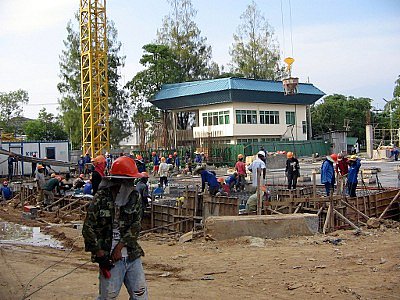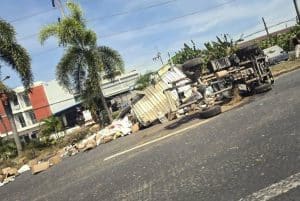Phuket’s new incinerator hits halfway mark

PHUKET: Work on Phuket’s second solid waste incinerator is nearly half complete. When finished, the facility will house the highest capacity trash-to-electricity plant in the country, Phuket City officials say.
The news follows a progress-update meeting on Tuesday of Tawarat Sutabutr, deputy director of the Department of Alternative Energy Development and Efficiency (DEDE); Phuket Mayor Somjai Suwansupapana; and Prachoom Suriya, head of the municipality’s environmental division.
Mr Tawarat said the Ministry of Energy would buy the power produced by the gasification facility, which is costing about 100 million baht to build.
Work on the plant is about 45% complete. When finished, its two burners will be capable of incinerating 700 tons of solid waste per day, he said.
The completed project will not mark the end of Phuket’s solid waste management problem, however.
“The amount of solid waste produced in Phuket has increased to 570 tons per day, a seven per cent increase over the last year. The capacity of the existing incinerator is only 250 tons per day,” Mayor Somjai said.
The remainder continues to pile up in the landfill behind the project.
Work on the project is scheduled for completion next year.
PJT, the Thai affiliate of Malaysian firm IRIS Technologies (M) Sdn Bhd, is building the plant and will manage it for 15 years. When it goes online, it will be able to contribute 14 megawatts of electricity to the local grid.
The existing plant has a rated production capacity of 2.5 megawatts, though actual production is typically about 1.6 megawatts because moisture in the waste stream reduces the plant’s burn efficiency.
There will certainly be no lack of fuel for the gasification, as there are already one million tons of waste piled up in the landfill, said Mayor Somjai.
She said the amount of solid waste generated on the island could triple over the next 10 years, outstripping the capacity of the new plant if improved waste management strategies are not implemented.
“We need to reduce this from three to five per cent by introducing better, more integrated solid waste management strategies,” she said.
Currently, all waste generated on the island must be sent to the old incinerator, which is located in a mangrove forest area on the fringe of Saphan Hin, the island’s largest and most popular public park.
— MCOT / The Nation
Latest Thailand News
Follow The Thaiger on Google News:
























